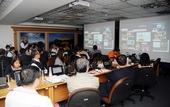Hot news

Mayor Cheng: Formulating a Plan for Implementing the Smart Schools and Digital Classroom Program
Release date:2016-03-24
Mayor Cheng: Formulating a Plan for Implementing the Smart Schools and Digital Classroom Program
Mayor Cheng: Formulating a Plan for Implementing the Smart Schools and Digital Classroom Program - Pilot Trials to be implemented in Selected Schools in Every District with the Hope of Improving Student Learning Motivation and PerformanceWhen hosting a Municipal Administration Meeting and viewing the report of “Smart School and Digital Classroom” offered by the Department of Education (DOE) on March 8th, Mayor Cheng requested the DOE to formulate an implementation plan according to the scale of the school and rural-urban differences. Schools should be selected in every district to carry out program trials. It is hoped that the program could improve learning motivation for students and make lessons more interesting. This program would be an extraordinary advantage for the education system in Taoyuan.
Mayor Cheng expressed that the “Smart School and Digital Classroom” Program incorporated creative digital learning and teaching models to improve learning motivation for students and to make lessons more interesting. He therefore asked the Department of Education to formulate relevant implementation plans to select schools from every urban and rural district according to the scale of schools. The implementation plan shall start with pilot trials conducted at schools selected in every district. Also, Taoyuan city government would hold more relevant events, such as seminar on topic of digital teaching material, digital note and course records, to help students have more interactivity through active learning that can increase the learning effectiveness.
Director-General, Kao An-Pang, of the Department of Education described that learning environments for “Smart School and Digital Classroom” shall be furnished with advanced technology and ergonomic features to improve interactivity. Teachers would be able to accurately assess the learning statuses of every student with the systems provided. Research from the American National Educational Technology Standards pointed out that technological applications in education had went through revolutionary changes which include student-oriented education, diversification of learning channels, and new learning models that include interactive participation, collaborative learning, investigative learning, and active response. Hence, this Program is aimed to change traditional education and establish an interactive learning model through the use of digital teaching materials. Learners would be able to pursue effective and active learning and become more willing to acquire new knowledge. Real-time feedback systems would be used to understand the learning statuses of individual students, and cloud analysis allow teachers to adjust teaching speeds and progresses any time.
Director-General Kao explained that both physical and digital teaching materials would be used simultaneously in the current phase. In the future, functions such as digital learning materials, digital notes, course recording, diagnostic repo

